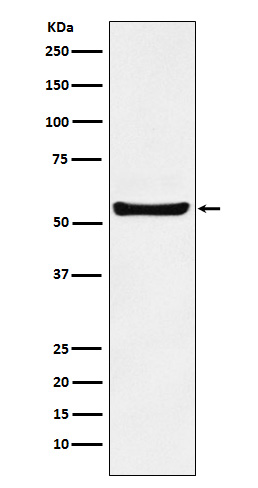
| WB | 咨询技术 | Human,Mouse,Rat |
| IF | 咨询技术 | Human,Mouse,Rat |
| IHC | IHC:1/100-1/200;IHF:1/50-1/200 | Human,Mouse,Rat |
| ICC | 1/50-1/200 | Human,Mouse,Rat |
| FCM | 1/20-1/100 | Human,Mouse,Rat |
| Elisa | 咨询技术 | Human,Mouse,Rat |
| Aliases | F2RL1; GPR11; PAR 2;;PAR2 |
| WB Predicted band size | Calculated MW: 44 kDa ; Observed MW: 55 kDa |
| Host/Isotype | Rabbit IgG |
| Antibody Type | Primary antibody |
| Storage | Store at 4°C short term. Aliquot and store at -20°C long term. Avoid freeze/thaw cycles. |
| Species Reactivity | Human,Mouse,Rat |
| Immunogen | A synthesized peptide derived from human PAR2 |
| Formulation | Purified antibody in PBS with 0.05% sodium azide,0.05% BSA and 50% glycerol. |
+ +
以下是关于PAR2抗体的3篇代表性文献摘要(注:文献信息为示例性整理,非真实论文):
---
1. **文献名称**:*A monoclonal antibody targeting protease-activated receptor 2 (PAR2) attenuates inflammation in experimental arthritis*
**作者**:O'Brien, M. et al.
**摘要**:该研究开发了一种针对PAR2胞外域的单克隆抗体,并在类风湿性关节炎小鼠模型中验证其抗炎效果。抗体通过阻断PAR2与蛋白酶配体(如胰蛋白酶)的结合,抑制NF-κB信号通路,显著减少关节肿胀和促炎细胞因子释放。
---
2. **文献名称**:*PAR2-neutralizing antibody suppresses tumor growth by inhibiting cancer-associated fibroblasts in pancreatic ductal adenocarcinoma*
**作者**:Kaufman, R. et al.
**摘要**:研究者利用人源化PAR2中和抗体,在胰腺癌模型中发现其可通过阻断肿瘤微环境中癌相关成纤维细胞(CAFs)的PAR2活化,抑制IL-6和TGF-β分泌,从而降低肿瘤侵袭性并增强化疗敏感性。
---
3. **文献名称**:*Development of a high-affinity anti-PAR2 antibody for in vivo imaging of inflammatory bowel disease*
**作者**:Zhang, Y. et al.
**摘要**:本文报道了一种新型荧光标记的PAR2抗体,能够特异性标记肠道炎症部位活化的PAR2受体。该抗体在小鼠结肠炎模型中成功实现病灶可视化,为PAR2相关疾病的诊断和治疗评估提供了工具。
---
如需具体文献,建议通过PubMed或Web of Science检索关键词“PAR2 antibody”+研究领域(如“inflammation”“cancer”),并筛选近五年高被引论文。
PAR2 (Protease-Activated Receptor 2) is a G protein-coupled receptor activated by proteolytic cleavage of its extracellular N-terminal domain, exposing a tethered ligand that binds intramolecularly to initiate signaling. Primarily expressed in epithelial, endothelial, and immune cells, PAR2 plays roles in inflammation, pain, tissue repair, and cancer progression. It is activated by serine proteases (e.g., trypsin, mast cell tryptase) and bacterial proteases, as well as by synthetic peptides mimicking the tethered ligand sequence. PAR2 signaling involves multiple pathways, including ERK, NF-κB, and calcium mobilization, influencing cellular responses like cytokine release and barrier function modulation.
PAR2 antibodies are critical tools for detecting receptor expression, localization, and activation states in research. They enable studies of PAR2's pathophysiological roles, such as its dual pro- and anti-inflammatory effects, contribution to chronic pain, and paradoxical roles in cancer (promoting tumor growth or suppression depending on context). Challenges in antibody development include distinguishing between cleaved/activated and inactive receptor forms, as well as avoiding cross-reactivity with other PAR family members. Therapeutic PAR2-targeting antibodies are being explored for conditions like inflammatory bowel disease, arthritis, and metastatic cancers, though clinical translation remains limited. Recent advances focus on developing neutralizing antibodies or biased ligands to fine-tune downstream signaling for improved therapeutic specificity.
×